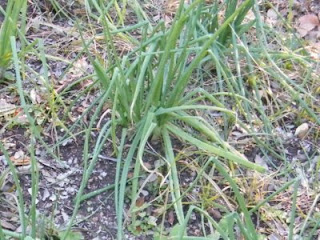It's the last full moon of 2012. Winter has still been unusually warm and dry. We've had a few mild freezes, but still plenty of days where I could wear short sleeves in the afternoon. We also noticed our water bill went up, probably because I've had to water the garden so much. I really wish it would rain. We have a chance of rain on Monday, so I hope it doesn't turn out to be another disappointment.
The Red Giant mustard and arugula are still getting eaten but not as badly. I've actually been able to harvest some. I guess this really shows that spicier greens are better defended against caterpillars.
I just planted the celery, which had been in pots. I've never grown celery before, but so far it's doing well. I've heard that celery needs a lot of water, though, so we'd better get some rain soon now that they're out in the garden.
The shallots seem to be doing fine. That's another thing I haven't grown before, so I hope they turn out to be easier to grow than onions, which I've never had much luck with.
The beets are struggling along due to lack of water. Chioggia is still doing the best, but that could be because it's right in the middle of the patch, while Bull's Blood is doing the worst, but it's on the edge. This is why it's better to have multiple repeats of any experiment.
The peppers are finally starting to look wilted after that last freeze. They were going along fine for the first few freezes, but that last one might have been a bit too much for them.
The luffa gourds aren't looking too good either. I was trying to give them as much time as possible to ripen the gourds they have, but they're still green. I doubt I'll get ripe gourds from them.
In the garage I've got my baby nightshades under lights. In the cellpack to the left I've got potato seedlings. I tried to grow some potatoes from seed last year, but they didn't make it once I transplanted. I'm trying again with the rest of the seeds, though I'll probably also buy some tubers. On the right I've got the tomatoes, peppers, and eggplants. They'll all go in their own individual pots once they get bigger.
Next I need to figure out what my 2013 Garden New Year's Resolutions will be!


















































